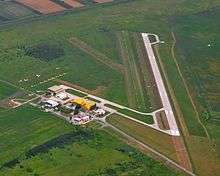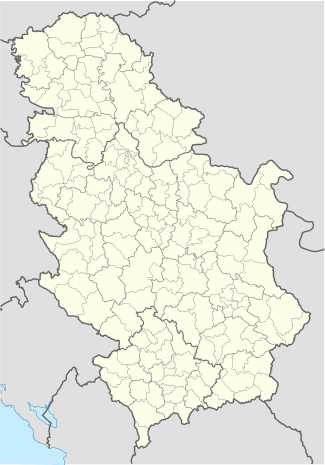Vršac International Airport
| Vršac Airport Aеродром Вршац Aerodrom Vršac | |||||||||||||||||||
|---|---|---|---|---|---|---|---|---|---|---|---|---|---|---|---|---|---|---|---|
 | |||||||||||||||||||
| IATA: none – ICAO: LYVR | |||||||||||||||||||
| Summary | |||||||||||||||||||
| Airport type | Public | ||||||||||||||||||
| Operator | SMATSA Aviation Academy | ||||||||||||||||||
| Serves |
Vršac, | ||||||||||||||||||
| Location | Vršac | ||||||||||||||||||
| Elevation AMSL | 276 ft / 84 m | ||||||||||||||||||
| Coordinates | 45°08′52″N 21°18′35″E / 45.14778°N 21.30972°ECoordinates: 45°08′52″N 21°18′35″E / 45.14778°N 21.30972°E | ||||||||||||||||||
| Website |
www | ||||||||||||||||||
| Map | |||||||||||||||||||
 VRC Location within Serbia | |||||||||||||||||||
| Runways | |||||||||||||||||||
| |||||||||||||||||||
Vršac Airport (Serbian: Aеродром Вршац / Aerodrom Vršac) (ICAO: LYVR), is a small airport and training facility owned and operated by the SMATSA Aviation Academy.
The airport is located in Vršac, eastern Serbia.
There are five hangars built at the airport, these accommodate aircraft of the flight school and of the agricultural aviation division. An office building with classrooms and a control tower are adjacent to hangars and the concrete aircraft apron. Runway width is 25 m (82 ft).
History
The first flight on the slopes of Mt. Vršac was performed by the Romanian pilot-engineer Aurel Vlaicu on August 11, 1912. The starting year of aeronautical tradition was 1925. when aeronautical club "Naša krila" (English: "Our Wings") was founded. A study was made about the advantages of this region for development of gliding sport, and this had initiated the investors to build the first hangar in 1934.
After World War II the intensive training of glider pilots continued. In 1954 Vršac becomes official State Aeronautical Centre. Glider pilots were now joined by parachutists, airplane pilots and aircraft-model makers. Vršac was the recruitment centre for recreational aeronautics until 1972. Fliers from this center took place in many world championships and brought many medals and records. In 1972 Vršac hosted the 13th World Gliding Championships (WGC).
In 1972 the national airline of Yugoslavia, JAT Yugoslav Airlines, now known as Air Serbia, started training future airline pilots at Vršac Airport.
The Jat Airways Flight Academy each year organizes the "Vršac Airshow".
The first international flight from Vršac Airport was to Podgorica Airport in Montenegro on February 5, 2007. The airport received international airport status after the Government of Serbia, made a decision to do so on December 28, 2006.
Airport services
SMATSA Aviation Academy
Vršac Airport is one of the most recognized European training centers and is the home to the SMATSA Aviation Academy, formerly known as the Jat Airways Flight Academy.
SMATSA Aviation Academy in Vršac has its own program based on over 50 years of experience in training pilots for commercial air transport. In its long tradition of pilot training, SMATSA Aviation Academy has trained over 2000 pilots and 70%+ of pilots flying today for the national air carrier - Jat Airways. The airport also includes a state of the art ALSIM flight simulator system.
In October 2005 the Maintenance Department of the SMATSA Aviation Academy received certification of conforming to European Union (JAA) standards in the maintenance of light aircraft - EASA part 145. This certification opens the possibility of maintaining aircraft for clients throughout Europe.
Vršac Airport has trained many pilots from different airports over the years. In 2007, the airport will be the training base for future pilots from India and China. Vršac Airport has also trained pilots from Air Algérie, Air Mali, Air Malta, Iraqi Airways, Libyan Arab Airlines, TAAG Angola Airlines and Turkish Airlines.
Maintenance
Light Aircraft Maintenance Center in Vršac at SMATSA Aviation Academy possesses the EASA 145 Certificate necessary for maintaining and repairing smaller planes from the European Union. Aircraft from the fleet of the Greek business air carrier GAA - whose pilots have recently renewed their flying licenses in the institution - are also maintained in Vršac.
Reconstruction
Major improvements are planned for the Vršac International Airport in the following few years. The existing runway, now at 1,200 m long, will be lengthened to 1,800 m. Runway width will be increased to 30 m. There will be strengthening of the runway, taxiway and terminal platform, to allow aircraft up to 30 tonnes weight. City authorities hope once the reconstruction will have been completed, international charter airlines, as well as cargo (DHL), will utilize airport services.
References
External links
- SMATSA Aviation Academy
- Opština Vršac
- Vršac airport information (PDF)
- Međunarodni aerodrom biće i u Vršcu (b92.net, 05.10.2011)
- I veliki avioni sletaće na aerodrom u Vršcu (eVrsac.rs, 18.02.2011)
- Airport information for LYVR at World Aero Data. Data current as of October 2006.